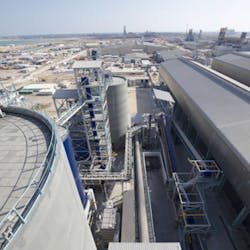In late 2009, Qatar Petroleum and Hydro Aluminum of Norway opened Qatalum (www.qatalum.com), a smelter plant capable of producing 585,000 metric tons of aluminum per year for the automotive, construction and engineering industries. It is the world’s largest primary smelter plant ever built in one phase, according to the company.
Located in Mesaieed Industrial City, Qatar, the smelter produces aluminum extrusion ingots and foundry alloys that are containerized and loaded on ships for export to sites around the world. One of the plant’s most important customers is also the country of Qatar itself, which is preparing to host the 2022 World Cup: At least nine new stadiums are being constructed along with the transportation infrastructure to accommodate fans.
The Qatalum plant’s footprint comprises 17 separate plant units, including a smelter, casthouse, carbon plant, and a dedicated gas-fired power plant with a capacity of about 1,350 MW. All are encompassed within a single process-control architecture for smelting.
The joint venture’s goal was to build one of the most cost-effective aluminum smelters in the world, as well as incorporate technology advances into this greenfield project. The fume treatment plant (FTP) is an important part of the goal. It reclaims harmful gases that are a byproduct of the aluminum production process. The FTP cleanses the industrial exhaust, but also cycles reclaimed material, such as sulfur, back through the smelting process to reduce the consumption rate of raw materials.
Tough Environment
Stuttgart, Germany-based ZMS Technology (www.zms-technology.com) designed and implemented the industrial network and network management systems that support the plant. With more than 1,000 network nodes after completion, it is the largest control network built in one phase in the Middle East.
Beyond size, Qatar’s arid environment and temperatures reaching 41 0C in the summer added to the design challenges. “The design required industrial-hardened Ethernet switches and a network management system that could automate instrument diagnostics and maintenance troubleshooting,” says Shariq Khan, technical manager for ZMS Technology.
Another objective with the network design was to standardize the network products to reduce installation time as well as day-to-day maintenance.
The network architecture features 100 Mbps Ethernet speed and a 1 Gbps backbone, in addition to centralized data communication and network monitoring. Network hardware specfications included hot-swappable media modules with high port density, high predictive hardware lifetime and mean-time-between-failure (MTBF) rates, and redundancy mechanisms.
“The network structure needed to ensure that no single point of failure could interrupt communication within the Qatalum plant,” Khan adds.
The network incorporates a combination of Hirschmann (www.hirschmann.com) products, including managed rail switches, MICE modular switches, MACH1000 substation switches, MACH4000 backbone switches and Eagle router/firewall security appliances. (Belden acquired Hirschmann Automation and Control in 2007. As a result, Hirschmann brand industrial switches and active devices combine with Belden cabling, connectivity and cable management products to provide a set of solutions for Industrial Ethernet networks.)
Quick Installation
ZMS Technology had a small window in which to install the industrial network, so it chose Hirschmann’s Industrial HiVision centralized network management system (NMS) to configure the network nodes and manage them over time. Designed specifically for industrial networks, Industrial HiVision comes with the HiFusion tool, which enables integration of Simple Network Management Protocol (SNMP) enabled devices from different manufacturers into a single network management application. Supported devices include switches, PLCs, I/O modules and HMI panels.
The MultiConfig tool within HiFusion allowed hundreds of plant network devices to be configured simultaneously, even while they were in live operation. In the Qatalum installation, the tool’s ability to identify inconsistencies between parameter configurations sped up installation and reduced troubleshooting time during site acceptance testing.
Now that the plant is operational, a single network administrator using the MultiConfig tool oversees the entire network and carries out repetitive but essential maintenance tasks such as regularly changing passwords and implementing firmware updates for the network management system.
Cable breakdown is a particular concern because the heat and arid conditions in Qatar can cause rapid cable disintegration. HiVision’s graphical interface allows operators not only to view all industrial network nodes such as unmanaged switches and hubs, but also drill down to the cable level to identify problematic connections.
In 2012, the greatest test of the network management software came when the system was upgraded. The upgrade required an audit of all 1,000 network nodes, and close to 100 changes were implemented and checked.
The audit required a complete review of the network, starting with the Layer 2 switches and continuing to the entire network infrastructure. It checked switches, network backbone and firewall connections to the IT department. Each PLC’s attachment to the network was verified, and the thousands of cables used for the deployment were checked for damage and accurately mapped.
“It took us eight days to complete the audit. If we had had to do it manually, it would have taken months, and even then we would not have been 100 percent sure the upgrade was complete,” says Khan.
The remote monitoring capabilities of Industrial HiVision were very appealing to Bashir Habib, head of IT infrastructure, at Qatalum. With 17 separate units at the facility, the company often encounters cable crimping and transmission errors, such as cyclic redundancy check (CRC) errors. Many of these problems are difficult to find without the aid of a monitoring system.
Habib says, “A centralized industrial network management system is an important element in overall plant operation that allows Qatalum to consistently meet production goals.”

